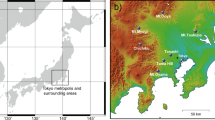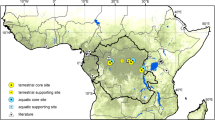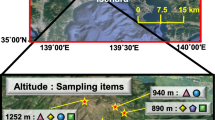Abstract
Atmospheric carbonyl sulfide (COS) mixing ratios measured over 24 h during five summer campaigns (2003–2007) in a forest at the foot of Mt. Fuji, Japan (35°21′ N, 138°43′ E; 1,300 m above sea level, a.s.l.) and at the summit (3,776 m a.s.l.) were compared. COS levels were lower at the foot than at the summit during four out of five summer campaigns. The ratios of COS mixing ratios at the foot of Mt. Fuji to those at the summit ranged from 0.7 to 0.9. These results provide evidence of biological consumption of COS in the East Asian atmospheric boundary layer. We also measured the vertical profile of ambient COS below the forest canopy. These data showed a clear gradient of COS mixing ratio: in the lowermost 1 m of the boundary layer, COS mixing ratios decreased markedly downward. Two of the different kinds of vertical distribution of COS presented here support the role of soil as a sink of atmospheric COS described by previous research using dynamic enclosure experiments.


Similar content being viewed by others
References
Andreae, M. O., & Crutzen, P. J. (1997). Atmospheric aerosols: Biogeochemical sources and role in atmospheric chemistry. Science, 276, 1052–1058.
Baldwin, B., Pollack, J. B., Summers, A., Toon, O. B., Sagan, C., & Van Camp, W. (1976). Stratospheric aerosols and climatic change. Nature, 263, 551–555.
Berresheim, H., & Vulcan, V. D. (1992). Vertical distributions of COS, CS2, DMS and other sulfur compounds in a loblolly pine forest. Atmospheric Environment, 26A, 2031–2036.
Blake, N. J., Streets, D. G., Woo, J.-H., Simpson, I. J., Green, J., Meinardi, S., et al. (2004). Carbonyl sulfide and carbon disulfide: Large-scale distributions over the western Pacific and emissions from Asia during TRACE-P. Journal of Geophysical Research, 109, D15S05. doi:10.1029/2003JD004259.
Campbell, J. E., Carmichael, Chai, T., Mena-Carrasco, M., Tang, Y., Blake, D. R., et al. (2008). Photosynthetic control of atmospheric carbonyl sulfide during the growing season. Science, 322, 1085–1088.
Castro, M. S., & Galloway, J. N. (1991). A comparison of sulfur-free and ambient air enclosure techniques for measuring the exchange of reduced sulfur gases between soils and the atmosphere. Journal of Geophysical Research, 96, 15427–15437.
Chin, M., & Davis, D. D. (1995). A reanalysis of carbonyl sulfide as a source of stratospheric background sulfur aerosol. Journal of Geophysical Research, 100, 8993–9005.
Conrad, R., & Meuser, K. (2000). Soils contain more than one activity consuming carbonyl sulfide. Atmospheric Environment, 34, 3635–3639.
Crutzen, P. J. (1976). The possible importance of CSO for the sulfate layer of the stratosphere. Geophysical Research Letters, 3, 73–76.
Diest, H. V., & Kesselmeier, J. (2008). Soil atmosphere exchange of carbonyl sulfide (COS) regulated by diffusivity depending on water-filled pore space. Biogeosciences, 5, 475–483.
Draxler, R. R., & Rolph, G. D. (2011). HYSPLIT (hybrid single-particle Lagrangian integrated trajectory) model access via NOAA ARL READY website (http://ready.arl.noaa.gov/HYSPLIT.php). NOAA Air Resources Laboratory, Silver Spring, MD.
Geng, C., & Mu, Y. (2004). Carbonyl sulfide and dimethyl sulfide exchange between lawn and the atmosphere. Journal of Geophysical Research, 109, D12302. doi:10.1029/2003JD004492.
Guo, H., Simpson, I. J., Ding, A. J., Wang, T., Saunders, S. M., Wang, T. J., et al. (2010). Carbonyl sul␣de, dimethyl sul␣de and carbon disul␣de in the Pearl River Delta of southern China: Impact of anthropogenic and biogenic sources. Atmospheric Environment, 40, 7018–7033.
Igarashi, Y., Sawa, Y., Yoshioka, K., Matsueda, H., Fujii, K., & Dokiya, Y. (2004). Monitoring the SO2 concentration at the summit of Mt. Fuji and a comparison with other trace gases during winter. Journal of Geophysical Research, 109, D17304. doi:10.1029/2003JD004428.
Igarashi, Y., Sawa, Y., Yoshioka, K., Takahashi, H., Matsueda, H., & Dokiya, Y. (2006). Seasonal variations in SO2 plume transport over Japan: Observation at the summit of Mt. Fuji from winter to summer. Atmospheric Environment, 40, 7018–7033.
Inomata, Y., Iwasaka, Y., Osada, K., Hayashi, M., Mori, I., Kido, M., et al. (2006). Vertical distributions of particles and sulfur gases (volatile sulfur compounds and SO2) over East Asia: Comparison with two aircraft-borne measurements under the Asian continental outflow in spring and winter. Atmospheric Environment, 40, 430–444.
Inomata, Y., Igarashi, Y., Yoshioka, K., Tanaka, T. Y., & Chiba, M. (2010). Temporal variation of 222Rn at the summit of Mt. Fuji associated with the Asian continental outflow. Atmospheric Environment, 44, 3856–3865.
Katayama, Y., Narahara, Y., Inoue, Y., Amano, F., Kanagawa, T., & Kuraishi, H. (1992). A thiocyanate hydrolase of Thiobacillus thioparus. A novel enzyme catalyzing the formation of carbonyl sulfide from thiocyanate. The Journal of Biological Chemistry, 267, 9170–9175.
Kato, H., Saito, M., Nagahata, Y., & Katayama, Y. (2008). Degradation of ambient carbonyl sulfide by Mycobacterium spp. in soil. Microbiology, 154, 249–255.
Kesselmeier, J., Teusch, N., & Kuhn, U. (1999). Controlling variables for the uptake of atmospheric carbonyl sulfide by soil. Journal of Geophysical Research, 104, 11577–11584.
Kettle, A. J., Kuhn, U., Von Hobe, M., Kesselmeier, J., & Andreae, M. O. (2002). Global budget of atmospheric carbonyl sulfide: Temporal and spatial variations of the dominant sources and sinks. Journal of Geophysical Research, 107, 4658. doi:10.1029/2002JD002187.
Kuhn, U., Ammann, C., Wolf, A., Meixner, F. X., Andreae, M. O., & Kesselmeier, J. (1999). Carbonyl sulfide exchange on an ecosystem scale: Soil represents a dominant sink for atmospheric COS. Atmospheric Environment, 33, 995–1008.
Lehmann, S., & Conrad, R. (1996). Characteristics of turnover of carbonyl sulfide in four different soils. Journal of Atmospheric Chemistry, 23, 193–207.
Liu, X. H., Penner, J. E., & Herzog, M. (2005). Global modeling of aerosol dynamics: Model description, evaluation, and interactions between sulfate and nonsulfate aerosols. Journal of Geophysical Research, 110(D18), D18206. doi:10.1029/2004JD005674.
Mihalopoulos, N., & Nguyen, B. C. (2001). Vertical distributions of carbonyl sulfide in a eucalyptus forest. Chemosphere—Global Change Science, 3, 275–282.
Mihalopoulos, N., Bonsang, B., Nguyen, B. C., Kanakidou, M., & Belviso, S. (1989). Field observations of carbonyl sulfide deficit near the ground: Possible implication of vegetation. Atmospheric Environment, 23, 2159–2166.
Miyawaki, A., Sugawara, H., & Hamada, T. (1971). Vegetation map of Mt. Fuji. In Tsuya H., et al. (Eds.), Mt. Fuji: Results of the cooperative scientific survey of Mt. Fuji. Tokyo: Fujikyuko (in Japanese).
Montzka, S. A., Calvert, P., Hall, B. D., Elkins, J. W., Conway, T. J., Tans, P. P., et al. (2007). On the global distribution, seasonality, and budget of atmospheric carbonyl sulfide (COS) and some similarities to CO2. Journal of Geophysical Research, 112, D09302. doi:10.1029/2006JD007665.
Mu, Y., Wu, H., Zhang, X., & Jiang, G. (2002). Impact of anthropogenic sources on carbonyl sulfide in Beijing City. Journal of Geophysical Research, 107(D24), 4769. doi:10.1029/2002JD002245.
Notsu, K., Mori, T., Chanchah Do Vale, S., Kagi, H., & Ito, T. (2006). Monitoring quiescent volcanoes by diffuse CO2 degassing: Case study of Mt. Fuji, Japan. Pure and Applied Geophysics, 163, 825–883.
Rolph, G. D. (2011). Real-time Environmental Applications and Display sYstem (READY) website (http://ready.arl.noaa.gov). NOAA Air Resources Laboratory, Silver Spring, MD.
Rotstayn, L. D., & Lohmann, U. (2002). Simulation of the tropospheric sulfur cycle in a global model with a physically based cloud scheme. Journal of Geophysical Research, 107(D21), 4592. doi:10.1029/2002JD002128.
Saito, M., Honna, T., Kanagawa, T., & Katayama, Y. (2002). Microbial degradation of carbonyl sulfide in soils. Microbes and Environments, 17, 32–38.
Simmons, J. S., Klemedtsson, L., Hultberg, H., & Hines, M. E. (1999). Consumption of atmospheric carbonyl sulfide by coniferous boreal forest soils. Journal of Geophysical Research, 104, 11569–11576.
Steinbacher, M., Bingemer, H. G., & Schmidt, U. (2004). Measurements of the exchange of carbonyl sulfide (OCS) and carbon disulfide (CS2) between soil and atmosphere in a spruce forest in central Germany. Atmospheric Environment, 38, 6043–6052.
Tsutsumi, Y., Zaizen, Y., & Makino, Y. (1994). Tropospheric ozone measurement at the top of Mt. Fuji. Geophysical Research Letters, 21, 1727–1730.
Xu, X., Bingemer, H. G., & Schmidt, U. (2002). The flux of carbonyl sulfide and carbon disulfide between the atmosphere and a spruce forest. Atmospheric Chemistry and Physics Discussions, 2, 181–212.
Yi, Z. G., Wang, X. M., Zhang, D. Q., Zhou, G. Y., Sheng, G. Y., & Fu, J. M. (2007). Soil uptake of carbonyl sulfide in subtropical forests with different successional stages in south China. Journal of Geophysical Research, 112, D08302. doi:10.1029/2006JD008048.
Acknowledgments
We thank staff at the Mt. Fuji Weather Station and staff from the nonprofit organization for “Valid Utilization of Mt. Fuji Weather Station” for assisting with air and soil sampling. We also thank all the researchers who gave technical supports and advice for data analysis. All soil sampling was conducted with permission from relevant government authorities. This study was partly supported by Grants-in-Aid for Scientific Research from the Ministry of Education, Culture, Sports, Science and Technology (nos. 416, 14380248, 17201007, 18310020).
Author information
Authors and Affiliations
Corresponding author
Rights and permissions
About this article
Cite this article
Kato, H., Igarashi, Y., Dokiya, Y. et al. Vertical Distribution of Carbonyl Sulfide at Mt. Fuji, Japan. Water Air Soil Pollut 223, 159–167 (2012). https://doi.org/10.1007/s11270-011-0847-0
Received:
Accepted:
Published:
Issue Date:
DOI: https://doi.org/10.1007/s11270-011-0847-0




